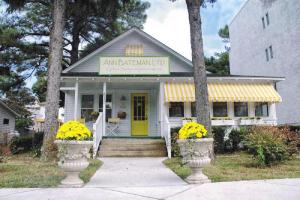Clear Space solves parking requirements with two buildings
From the very beginning, code-required parking has been one of the biggest questions associated with Clear Space Theatre Company’s proposed theater on Rehoboth Avenue. It appears that question has been resolved with a new two-building design, instead of the one originally proposed.
In October 2018, Clear Space introduced plans for a new 25,600-square-foot home near the circle, at 413, 415 and 417 Rehoboth Ave. Depending if the project were categorized institutional or commercial, under city code, a project of that size would require as few as 64 parking spaces or as many as 128. Clear Space was offering 28.
During a meeting March 10, it was revealed Clear Space has changed the design of the theater to two buildings – a 256-seat theater at less than 15,000 square feet and an administrative office at less than 9,000, with a courtyard in the middle.
The proposed design change wasn’t lost on members of the public at the meeting, including former Rehoboth Beach Planning Commission Chair David Mellen, who was on the commission in 2018. By scaling the project down into a double package, he said, Clear Space is trying to avoid the parking problems and the site-plan review process, which was the city process Clear Space undertook in 2018.
At the conclusion of the meeting, Clear Space Executive Director Wesley Paulson declined to respond to Mellen, but he did confirm the new square-footage amounts of the project were correct. He said Clear Space expected the plans to be submitted to the city in the next few weeks.
In an email March 12, City Building Inspector Damalier Molina said new design plans for Clear Space had not been submitted, but he said no parking spaces would be required if the plans showed both buildings fall under the umbrella of a theater. In an email March 13, Paulson confirmed Clear Space plans on submitting the whole two-building design as a theater.
413 Rehoboth Ave. deemed historic structure
The actual purpose of the meeting, held at the Rehoboth Beach Museum, was to gather suggestions on how to best preserve 413 Rehoboth Ave., because the structure has been designated as a rare surviving example of a beach bungalow. The house at 415 Rehoboth Ave. did not receive the same designation.
The designation came as part of an environmental assessment required by the United States Department of Agriculture for a $4.8 million community facilities loan Clear Space has applied for to help fund the $8.8 million project. The new design of the project was read as part of an introductory statement.
According to Terry Fearins, USDA community program director for Delaware and Maryland, the loan would have an interest rate of 2.375 percent, which she said is the same rate the city received on the $18 million the USDA loaned for the new city hall under the same loan program. She said Clear Space can apply because Rehoboth Beach does not exceed the population maximum of the loan.
Now that the cottage has been deemed historically significant, Fearins said Clear Space and the USDA will enter into a Memorandum of Understanding on how to implement a mitigation plan for the building, which could be moving the building or incorporating design elements into a new building.
The only reason a mitigation plan is being considered is because Clear Space has applied for the federal loan. If the project was privately funded, there wouldn’t be this process, said Fearins.
Most of the discussion at the meeting was not about a mitigation plan. Mellen wasn’t the only person to bring up parking, especially in the residential neighborhood north of the Rehoboth Avenue lots. Others said they didn’t think the USDA should be giving a low-interest loan for a project in a town as affluent as Rehoboth.
Related to a mitigation plan, some members of the public suggested moving the building; creating an art project and installing it in the courtyard; demolishing the building but incorporating salvaged pieces in the new construction; or constructing the new buildings around the cottage.
Paulson said Clear Space has looked into moving the building, but was told it would cost tens of thousands of dollars and was cost prohibitive.
At the conclusion of the meeting, Fearins said it would take a few weeks for the MOU to be drafted and approved. She said the USDA is still taking comments on the mitigation plan, which can be sent to her at terry.fearins@usda.gov., or to Community Program Specialist Lisa Fitzgerald at lisa.fitzgerald2@usda.gov.
Editor’s Note: The online story has been updated from the print version that ran Friday, March 13, to clarify why no parking spots would be required.
Chris Flood has been working for the Cape Gazette since early 2014. He currently covers Rehoboth Beach and Henlopen Acres, but has also covered Dewey Beach and the state government. He covers environmental stories, business stories and random stories on subjects he finds interesting, and he also writes a column called Choppin’ Wood that runs every other week. Additionally, Flood moonlights as the company’s circulation manager, which primarily means fixing boxes that are jammed with coins during daylight hours, but sometimes means delivering papers in the middle of the night. He’s a graduate of the University of Maine and the Landing School of Boat Building & Design.























































